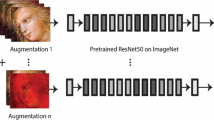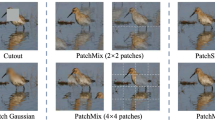Abstract
Image recognition by deep learning usually requires many sample images to train. In case of a small number of images available for training, data augmentation techniques should be applied. Here we propose a novel image augmentation technique based on a random permutation of coefficients of within-class principal components obtained after applying Principal Component Analysis (PCA). After reconstruction, newly generated surrogate images are employed to train a deep network. In this study, we demonstrated the applicability of our approach on training a custom convolutional neural network using the CIFAR-10 image dataset. The experimental results show an improvement in terms of classification accuracy and classification ambiguity.
Access this chapter
Tax calculation will be finalised at checkout
Purchases are for personal use only
Similar content being viewed by others
References
Schmidhuber, J.: Deep learning in neural networks: an overview. Neural Netw. 61, 85–117 (2015). https://doi.org/10.1016/j.neunet.2014.09.003
Rawat, W., Wang, Z.: Deep convolutional neural networks for image classification: a comprehensive review. Neural Comput. 29(9), 2352–2449 (2017)
Ayinde, B.O., Inanc, T., Zurada, J.M.: Regularizing deep neural networks by enhancing diversity in feature extraction. IEEE Trans. Neural Netw. Learning Syst. 30(9), 2650–2661 (2019). https://doi.org/10.1109/TNNLS.2018.2885972
Shorten, C., Khoshgoftaar, T.M.: A survey on image data augmentation for deep learning. J. Big Data 6(1), 1–48 (2019). https://doi.org/10.1186/s40537-019-0197-0
Qi, G.-J., Luo, J.: Small data challenges in big data era: a survey of recent progress on unsupervised and semi-supervised methods. CoRR abs/1903.11260 (2019)
Leng, B., Yu, K., **gyan, Q.I.N.: Data augmentation for unbalanced face recognition training sets. Neurocomputing 235, 10–14 (2017)
Chen, H.Y., Li, D.C., Lin, L. S.: Extending sample information for small data set prediction. In: 2016 5th IIAI International Congress on Advanced Applied Informatics (IIAI-AAI), pp. 710–714 (2016)
Truong, T.N., Dam, V.D., Le, T.S.: Medical images sequence normalization and augmentation: improve liver tumor segmentation from small dataset. In: 3rd International Conference on Control, Robotics and Cybernetics (CRC), pp. 1–5 (2018)
Li, W., Chen, C., Zhang, M., Li, H., Du, Q.: Data augmentation for hyperspectral image classification with deep CNN. IEEE Geosci. Remote Sens. Lett. 16(4), 593–597 (2019)
Haut, J.M., Paoletti, M.E., Plaza, J., Plaza, A., Li, J.: Hyperspectral image classification using random occlusion data augmentation. IEEE Geosci. Remote Sens. Lett. 16(11), 1751–1755 (2019). https://doi.org/10.1109/LGRS.2019.2909495
Dirvanauskas, D., Maskeliūnas, R., Raudonis, V., Damaševičius, R., Scherer, R.: Hemigen: human embryo image generator based on generative adversarial networks. Sensors 19(16), 3578 (2019)
Womg, A., Shafiee, M.J., Li, F., Chwyl, B.: Tiny SSD: a tiny single-shot detection deep convolutional neural network for real-time embedded object detection. In: 15th Conference on Computer and Robot Vision (CRV), Toronto, ON, pp. 95–101 (2018)
Zhou, Z.-H., Wu, J., Tang, W.: Ensembling neural networks: Many could be better than all. Artif. Intell. 137(1–2), 239–263 (2002). https://doi.org/10.1016/s0004-3702(02)00190-x
Amory, A.A., Muhammad, G., Mathkour, H.: Deep convolutional tree networks. Future Generation Comput. Syst. 101, 152–168 (2019). https://doi.org/10.1016/j.future.2019.06.010
Basha, S.H.S., Dubey, S.R., Pulabaigari, V., Mukherjee, S.: Impact of fully connected layers on performance of convolutional neural networks for image classification. Neurocomputing 378, 112–119 (2019). https://doi.org/10.1016/j.neucom.2019.10.008
Krizhevsky, A.: Learning multiple layers of features from tiny images. Master’s thesis, Department of Computer Science, University of Toronto, Canada (2009)
Mordvintsev, A., Olah C., Tyka, M.: Inceptionism: Going deeper into neural networks. Google research blog (2015)
Goodfellow, I.J., Warde-Farley, D., Mirza, M., Courville, A., Bengio, Y.: Maxout networks. ar**v:1302.4389 (2013)
Huang, G., Liu, Z., Weinberger, K. Q., van der Maaten, L.: Densely connected convolutional networks. ar**v preprint ar**v:1608.06993 (2016)
Zagoruyko, S., Komodakis, N.: Wide residual networks. ar**v:1605.07146 (2016)
Najgebauer, P., Grycuk, R., Rutkowski, L., Scherer, R., Siwocha, A.: Microscopic sample segmentation by fully convolutional network for parasite detection. In: Rutkowski, L., Scherer, R., Korytkowski, M., Pedrycz, W., Tadeusiewicz, R., Zurada, Jacek M. (eds.) ICAISC 2019. LNCS (LNAI), vol. 11508, pp. 164–171. Springer, Cham (2019). https://doi.org/10.1007/978-3-030-20912-4_16
Aizenberg, I., Luchetta, A., Manetti, S., Piccirilli, M.C.: A MLMVN with arbitrary complex-valued inputs and a hybrid testability approach for the extraction of lumped models using FRA. J. Artif. Intell. Soft Comput. Res. 9(1), 5–19 (2019)
Costa, M., Oliveira, D., Pinto, S., Tavares, A.: Detecting driver’s fatigue, distraction and activity using a non-intrusive Ai-based monitoring system. J. Artif. Intell. Soft Comput. Res. 9(4), 247–266 (2019)
Acknowledgments
Authors acknowledge contribution to this project of the Program “Best of the Best 4.0” from the Polish Ministry of Science and Higher Education No. MNiSW/2020/43/DIR/NN4.
Author information
Authors and Affiliations
Corresponding author
Editor information
Editors and Affiliations
Rights and permissions
Copyright information
© 2020 Springer Nature Switzerland AG
About this paper
Cite this paper
Abayomi-Alli, O.O., Damaševičius, R., Wieczorek, M., Woźniak, M. (2020). Data Augmentation Using Principal Component Resampling for Image Recognition by Deep Learning. In: Rutkowski, L., Scherer, R., Korytkowski, M., Pedrycz, W., Tadeusiewicz, R., Zurada, J.M. (eds) Artificial Intelligence and Soft Computing. ICAISC 2020. Lecture Notes in Computer Science(), vol 12416. Springer, Cham. https://doi.org/10.1007/978-3-030-61534-5_4
Download citation
DOI: https://doi.org/10.1007/978-3-030-61534-5_4
Published:
Publisher Name: Springer, Cham
Print ISBN: 978-3-030-61533-8
Online ISBN: 978-3-030-61534-5
eBook Packages: Computer ScienceComputer Science (R0)




